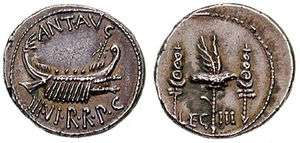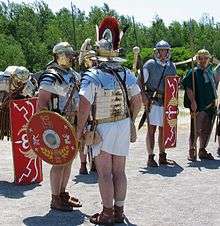Legio III Cyrenaica


Legio tertia Cyrenaica ("Cyrenean Third Legion") was a legion of the Imperial Roman army. The origins of the legion remain unknown. One source believes the legion was probably founded by Mark Antony around 36 BC, when he was governor of Cyrenaica. Equally, the legion's origins may come from the fact it was commanded by Lucius Pinaris Scarpus, an ally of Mark Antony whom Antony appointed to be governor of Cyrenaica in eastern Libya.[1] There are still records of the legion in Syria in the beginning of the 5th century. The legion symbol is unknown.
History
Legion III Cyrenaica was one of the longest-living Roman legions. The origin of the title/name Cyrenaica is not known - it may have been given to the Legion to signify its origin in Cyrene (now Libya), or to signify a major victory or for notable action in that province.
Difficulties tracing the history of any Roman legion, including III Cyrenaica, are multiple. Firstly, contemporary historians (Cary & Scullard; Pat Southern; Michael Grant; Phil Barker; Stephen Dando-Collins; Pollard & Berry) agree that there are significant gaps in available records; hence, it is often impossible to authoritatively state that a specific legion was responsible for a specific action. Secondly, when discussing Roman legions, there is often confusion—especially after Augustus became Caesar until the end of the empire some 500 years later—caused by the Roman habit of numbering several legions over successive centuries as "III Legion". Distinguishing between the legions is only done via regional title such as III Cyrenaica etc. To illustrate the confusion this causes, authoritative sources list that in AD 20, just in the southern and eastern Mediterranean, there is a Legio III Augusta stationed in Africa, a Legio III Cyrenaica in Egypt and a Legio III Gallica in Syria.[2]
Legio III Cyrenaica may have been primarily stationed in Alexandria, Egypt, sharing a 'double-fortress' with Legio XXII Deiotariana, where it may have stayed for about one hundred years before re-locating to Bostra, Syria. However, the Roman habit of sending vexillations (detachments, often one or more cohorts of around 480 troops each) from parent legions to be assigned to campaigns, these assignments often lasting several years, significantly complicates making absolute statements regarding which legions fought in any specific location.[3] Furthermore, in the case of the list below, just how long III Cyrenaica may have served with XXII Deiotariana as the garrison of Egypt is unclear; another Egypt-based Roman legion—II Traiana Fortis—is credited with having garrisoned Egypt with XXII Deiotariana from AD 127.[4] Equally, in the Parthian campaigns, which of those legions bearing the designation III served in Parthia is difficult to ascertain (sources credit at least three.[5] Gnaeus Domitius Corbulo (a Roman general who campaigned against the Parthians in Armenia in the period AD 55-67), is known to have received vexillations from the Egypt garrison, but the identity of the legions supplying the vexillations is unclear.[6] In AD 215, during the reign of the emperor Caracalla, Legio III Parthica is listed as assigned to Mesopotamia (suggesting direct involvement in a Parthian campaign), Legio III Gallica as garrisoning Syria, Legio III Augusta as assigned to North Africa, whilst Legio III Cyrenaica is listed as assigned to Arabia Petraea.[7] Emperor Septimius Severus in AD 197 is known to have raised three legions–I, II and III Parthica—for service in the east, leaving Legio II Parthica in Rome, but taking the other two legions with him on his Parthian campaign.[8] From c. AD 140 to AD 395, Legio III Cyrenaica is known to have been garrisoned at Bosra (Bostra) in southern modern-day Syria, east of the Sea of Galilee.[9]
The following is a list of campaigns and actions thought to have been seen by Legion III Cyrenaica during much of its existence:
- 35(?) BC - Leg. III is formed, likely by Mark Antony or Lepidus in Cyrene. At this time, Legions still likely hold to the Republic tradition of being numbered in order of their creation, so this may have been the third Legion that [Anthony] had established and had under his direct command and loyalty.
- 31 BC - (Battle of Actium) - Either before or after Anthony and Cleopatra are defeated by Octavian (later Augustus), it is thought soldiers of Leg. III Cyrenaica defect from Anthony and claim allegiance to Octavian - who spares the Legion from being disbanded.
- 26 - 25 BC - Action in Arabia Felix (Yemen), commanded by Aelius Gallus, Prefect of Egypt.
- 23 BC - Action against Nubian invaders, Elements of III likely stationed in Thebes, Egypt.
- 23(?) BC (AD?) - Roman military presence in Egypt is reduced to 2 Legions: III Cyrenaica and XXII Deiotariana. Which other Legions, or how many there were, is not known.
- AD 7 - 11 - Suggested time period that the double-fortress at Nikopolis is established.
- AD 11 - Elements of Leg III under command of Publius Juventius Rufus, stationed in Berenike.
- AD 39 / 40 - A detachment (vexillation) of Leg III was sent up to the northern coast of Gaul (France) to assist Emperor Caligula's legions with his rather unimpressive invasion of Britain. III was apparently used as a logistics and supplies organizer for the invasion / landing force.
- AD 58 - 63 - Under the command of Gn. Domitius Corbulo, elements of III saw action in the Parthian frontier.
- AD 66 - 70 - The First Jewish–Roman War. An uprising of Jews starts in Alexandria, and spreads to Judea. Elements of III and XXII fought their way to Jerusalem, and with the assistance of several other legion, auxiliary and allied forces (around 60,000 troops) surrounded and besieged the city, led by Vespasian, Proconsul of Africa.
- AD 69 - "Year of the Four Emperors". Factions led by Galba, Otho, and then Vitellius all tried to seize control of Rome after the death of Nero. These factions, who had no aristocratic claim to the throne, (and hardly any support of the legions nor the Senate) all tried to take control one after another by force.
- July 1 - With support of Gaius Licinius Mucianus, Governor of Syria and Tiberius Alexander, Prefect of Egypt, Vespasian is urged to revolt and take the throne. The legions in Alexandria, two days later those of Judea, and then in August those of Syria and the Danube region declare Vespasian Emperor. Vespasian sends Mucianus to march on Rome with 20,000 troops while Vespasian heads to Alexandria to control the grain supply and starve Rome into submission.
- December 22 Vespasian is sworn in as emperor while still in Egypt.
- AD 70 - A vexillation of Leg III, along with X Fretensis, completes the siege of Jerusalem under the command of Vespasian's son, Titus.
- AD 84 - 88 - It is believed a detachment of Leg III is sent to help repair a footbridge along the Danube River, with legions VII Claudia, IV Flavia Felix, and either I or II Adiutrix. A stone engraving commemorating the bridge mentions "The Legion from Egypt". III appears to have been sent out abroad more often than XXII, so it is possible this is referring to III.
- AD 90 - Soldiers of III construct a bridge in Koptos (likely to improve or support roads to ports in Berenike and Quseir).
- AD 107 - 109 - Previously suggested date when Leg III departs Egypt - May instead be elements of III on expeditionary missions into Syria.
- AD 116 - Elements of III (or XXII?) are sent back to Judea to suppress another revolt, known as the Kitos War
- AD 120 or 127 - III makes its departure from Egypt, being relocated to Bosra (aka Bostra, Syria / Jordan), where the capital was renamed from Petra to Nova Trajana Basra honoring Emperor Trajan. While in Bosra, Leg III constructs city gates, bridges and a massive amphitheater, which still exists today and is a popular tourist attraction. Meanwhile Legion II Trajana Fortis replaces III in Egypt.
- AD 132 - 136 - Yet another Jewish war, the Bar Kokhba revolt. It is thought elements of III and XXII are sent to Judea. Legion XXII may have been destroyed during this war, or perhaps the earlier Kitos War.
- AD 162 - 166 - Elements of III again in Parthia, under command of Lucius Verus.
- AD 193 - Leg III supported Pescennius Niger in his failed attempt to take the throne after Emperor Commodus.
- AD 262 - 267 - It is possible that elements of III were involved with fighting Queen Zenobia in Palmyra (Syria).
- AD 420s or 430s - III is listed in the Notitia Dignitatum - a record of Roman military units and their stations. Legion III is listed as Praefectus legionis tertiae Cyrenaicae, Bostra.
- AD 630 (?) III Cyrenaica is likely destroyed fighting the Muslim conquest of the Levant.
(Information researched and compiled by group members of Leg. III Cyrenaica, a Roman Legion Reenacting/Living History group, see link below)
See also
External links and references
- ↑ Pollard N. & Berry J., 'The Complete Roman Legions', p 156
- ↑ see Grant M. 'The Army of the Caesars' pp.291-294 and also Pollard N. & Berry J., 'The Complete Roman Legions', pp.112, 120, 130 and 172
- ↑ see Barker P., 'The Armies and Enemies of Imperial Rome', p.20 for an example of this difficulty in ascertaining unit identity
- ↑ Pollard N. & Berry J., 'The Complete Roman Legions', pp.120-129 and p.155
- ↑ see Grant, Pollard, Southern and Cary, all of whom list multiple entities
- ↑ Southern P., 'The Roman Army: A Social and Institutional History', pp.299-301
- ↑ Grant M., 'The Armies of the Caesars', pp.293-294. Grant acknowledges his data is drawn from Balsdon J., 'Rome: The Story of an Empire', published in 1970
- ↑ Southern P., 'The Roman Army: A Social and Institutional History', p.319
- ↑ Pollard N. & Berry J., 'The Complete Roman Legions', p.157
- Richard Alston - "Soldier and Society in Roman Egypt: A social history", Routledge Press 1995.
- Emil Ritterling - "Legio" article published in Realencyclopädie of Klassischen Altertumswissenschaft in 1925
- H. A. Sanders - JSTOR article written 1941)
- John Paul Adams - (California State University, Northridge)
- Adrian Goldsworthy - "The Complete Roman Army", Thames & Hudson 2003.
- Jona Lendering - Livius.org
- Peter Connolly - "Greece and Rome at War", Greenhill Books 1981, 1998.
- Phil Barker - "The Armies and Enemies of Imperial Rome", Wargames Research Group Publications 1981.
- Bishop & Coulston - "Roman Military Equipment", Oxbow Books 1993.
- De Imperatoribus Romanis (On the Roman Emperors)
Osprey books:
- Simkins / Embelton - The Roman Army from Caesar to Trajan (Men at Arms #46)
- Cowan / McBride - Roman Legionary: 58 BC - AD 69 (Warrior #71)
- Sumner - Roman Military Clothing 1,2,3 (Men at Arms #374, 390, 425)
- Campbell / Hook - Siege Warfare in the Roman World (Elite #126)
- Cowan / Hook - Roman Battle Tactics: 109 BC - AD 313 (Elite #155)
- Gilliver / Goldsworthy / Whitby - Rome At War: Caesar and his Legacy (Essential Histories)
Bibliography
| Wikimedia Commons has media related to Legio III Cyrenaica. |
- Emil Ritterling, Legio, Realencyclopädie of Klassischen Altertumswissenschaft, 1925, Columns 1506-1514
- H. A. Sanders, "The Origin of the Third Cyrenaic Legion", American Journal of Philology, 62 (1941), pp. 84–87.
- Johannes Kramer, "Die Wiener Liste von Soldaten der III. und XXII. Legion (P. Vindob. L 2)", Zeitschrift für Papyrologie und Epigraphik, 97 (1993), pp. 147–158
- G. W. Bowersock, "A Report on Arabia Provincia", The Journal of Roman Studies, 61 (1971), pp. 219–242
- Karl Strobel, "Zu Fragen der frühen Geschichte der römischen Provinz Arabia und zu einigen Problemen der Legionsdislokation im Osten des Imperium Romanum zu Beginn des 2. Jh.N.Chr", Zeitschrift für Papyrologie und Epigraphik, 71 (1988), pp. 251–280
- John Peter Oleson, M. Barbara Reeves, Barbara J. Fisher, "New Dedicatory Inscriptions from Humayma (Ancient Hawara), Jordan", Zeitschrift für Papyrologie und Epigraphik, 140 (2002), pp. 103–121
- P.-L. Gatier, "La Legio III Cyrenaica et l'Arabie", in dans Les légions de Rome sous le Haut-Empire, I, Lyon, 2000, p. 341-344
- A. Kindler, The Coinage of Bostra (Warminster 1983) 87-95.
- D. Kennedy originally, "Legio VI Ferrata: The Annexation and Early Garrison of Arabia", Harvard Studies in Classical Philology, 84 (1980) 282-309

